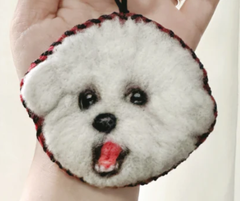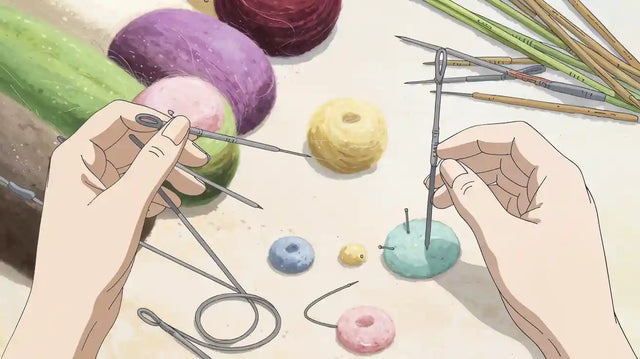How to Choose the Best Wool for Felting Crafts in 2025
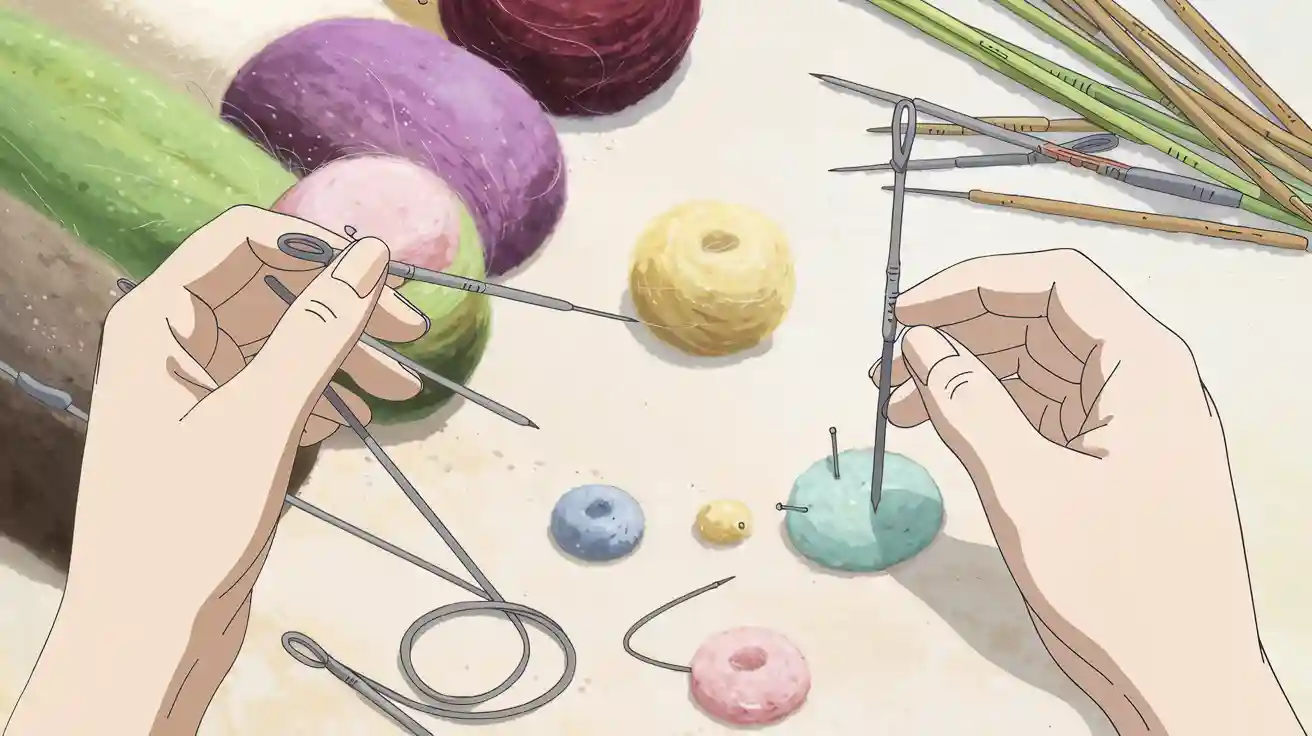
If you want great needle felting results this year, use pure wool felt or good wool blend felt. These are the best choices in 2025. Natural wool felt and eco-friendly colored felts are also getting more popular at stores like Thefeltstore and JO-ANN STORES. Picking the right wool for felt is very important. It matters a lot for projects that need small details, like custom pet portraits. Merino wool gives soft and smooth results. Corriedale wool gives more texture and depth. When you pick the right wool felt, your needle felting projects look real and last longer.
Key Takeaways
Choose 100% natural wool from breeds like Merino, Corriedale, or Shetland for the best felting results.
Use carded wool for building shapes and tops or locks for adding fine details and texture.
Pick fine, soft wool like Merino for delicate details and coarser wool like Corriedale for strong bases.
Buy wool with good crimp and low guard hairs to ensure your projects last and look smooth.
Support eco-friendly wool by buying from local farms or brands with responsible labels like RWS or GOTS.
Best Wool for Felt
Top Breeds
When you look for wool for felt, you will see many sheep breeds. Each breed gives a different felting result. Some wool is soft and easy to shape. Other wool is strong and good for tough crafts. Here is a table to help you compare the most popular breeds for wool for felt in 2025:
Sheep Breed |
Advantages for Felting Crafts |
Disadvantages for Felting Crafts |
|---|---|---|
Corriedale |
Durable, lustrous wool; easy to spin; high wool yield; adaptable to many climates; hardy and long-lived |
Some genetic defects reported; smaller carcass size |
Rambouillet |
Fine, soft wool ideal for delicate felting projects; high-quality fiber |
May have higher lanolin content making processing more involved |
Shropshire |
Medium wool with good felting properties; balanced softness and durability |
Less widely available; may have moderate lanolin content |
Romney |
Coarser wool, excellent for sturdy felted items like rugs; good durability |
Wool may be pricklier and less suitable for next-to-skin projects |
You will often find Merino, Corriedale, and Shetland wool in felting kits. Merino wool is very soft and felts fast, but you must be gentle. Corriedale wool is great for beginners. It is easy to use and has a nice mix of softness and strength. Shetland wool is soft and has good crimp, so it bounces back into shape. You can use Shetland wool for animals, flat felting, or adding texture. Shetland wool works for both needle and wet felting. If you want wool that is easy to control, Shetland wool is a good pick. Shetland wool comes in natural colors, so you can make real-looking shading. Many crafters like Shetland wool because it is useful and looks classic. Shetland wool is not too slippery, so shaping is simple. Shetland wool gives a nice finish for 3D animals or flat pictures.
Lanolin is something else to think about. Some breeds, like Merino, have more lanolin. This makes the wool greasy and harder to clean. Shetland wool has less lanolin, so it is easier to use and get ready for felting. The amount of lanolin also changes how the wool reacts to water and felting needles.
Tip: If you want to make a project with lots of detail, like a custom pet portrait, pick a breed with soft, fine fibers. Shetland wool and Merino wool are both great for this.
Wool Preparation
Let’s talk about how wool is prepared for felt. The way wool is made ready changes how easy it is to use and what results you get. Here is a table to show the main types:
Wool Preparation |
Fiber Orientation |
Texture & Characteristics |
Typical Felting Uses |
|---|---|---|---|
Carded Batts |
Fibers in various directions |
Thick, soft, lofty, quick to felt |
Core wool, building basic shapes, flat features, blending colors, creating art batts with mixed fibers |
Slivers |
Mostly aligned fibers but some mixed |
Long rope-like, soft, lofty |
Wrapping armature wire, building shapes in needle and wet felting, good for beginning and middle construction stages |
Tops |
All fibers aligned in one direction |
Smooth, soft, thicker than slivers, vegetable matter removed |
Precision work, top coats, realistic fur effects, especially with merino wool, layering for realistic fur |
Locks |
Natural curly fibers, uncarded |
Curly, natural texture |
Adding curly textures like manes, curly fur, used for specific breeds or mohair |
Carded wool is the most common for beginners. Carded batts are fluffy and easy to poke with a needle. You can use carded batts to build the main shape of your project. Carded wool tangles fast, so you do not need to work hard for a solid base. Carded wool is also good for mixing colors. If you want a smooth surface, add a layer of tops or roving on your carded wool base. Carded slivers are long and soft. You can wrap them around wire or use them to build shapes.
Tops are another kind of wool for felt. The fibers in tops all go one way. This makes them smooth and good for adding small details, like fur or hair. You can use wool roving for the top coat of animal sculptures. Wool roving is also good for layering colors and making your project look real. If you want curls or texture, use locks. Locks are curly pieces of wool from the sheep. They are great for manes, curly tails, or special effects.
If you make a high-detail project, like the Pawimprint Pet Portrait Custom Frame, you need to use good carded wool and the right breed. The artists at Pawimprint use soft, high-quality carded wool to show every detail of your pet’s face. They use carded batts for the base, then add tops and wool roving for the surface. Using different kinds of wool makes the portrait look real and last a long time.
Note: Carded wool is easier for beginners. Tops and locks give more control for small details. Try mixing carded batts, carded slivers, and wool roving to get the best results for your felting projects.
Wool batting is another choice if you want to make flat felt or big backgrounds. It is thick and covers large areas fast. Shetland wool works well as batting too. When you know how carded wool, carded batts, carded slivers, tops, and locks work, you can pick the best wool for any felting project.
Wool for Needle Felting
Texture and Fineness
When you pick wool for needle felting, you want to look at three things: texture, fineness (micron count), and crimp. These qualities change how your project feels and looks. Finer wool, like Merino, has a low micron count. This means the fibers are very thin and soft. High crimp means the wool is springy and holds its shape well. If you want to make tiny details or smooth surfaces, choose fine, soft wool with lots of crimp.
Here’s a quick table to help you compare popular types of needle felting wool:
Wool Breed |
Micron Count |
Crimp Level |
Texture/Characteristics |
Best For |
|---|---|---|---|---|
Merino |
18-22 |
High |
Super soft, elastic |
Delicate, detailed felting |
Corriedale |
24-31 |
Distinct |
Balanced softness, durable |
Robust, easy felting |
Romney |
27-35 |
Medium |
Lustrous, firm |
Firm shapes, sturdy crafts |
You can also see how micron counts compare in this chart:
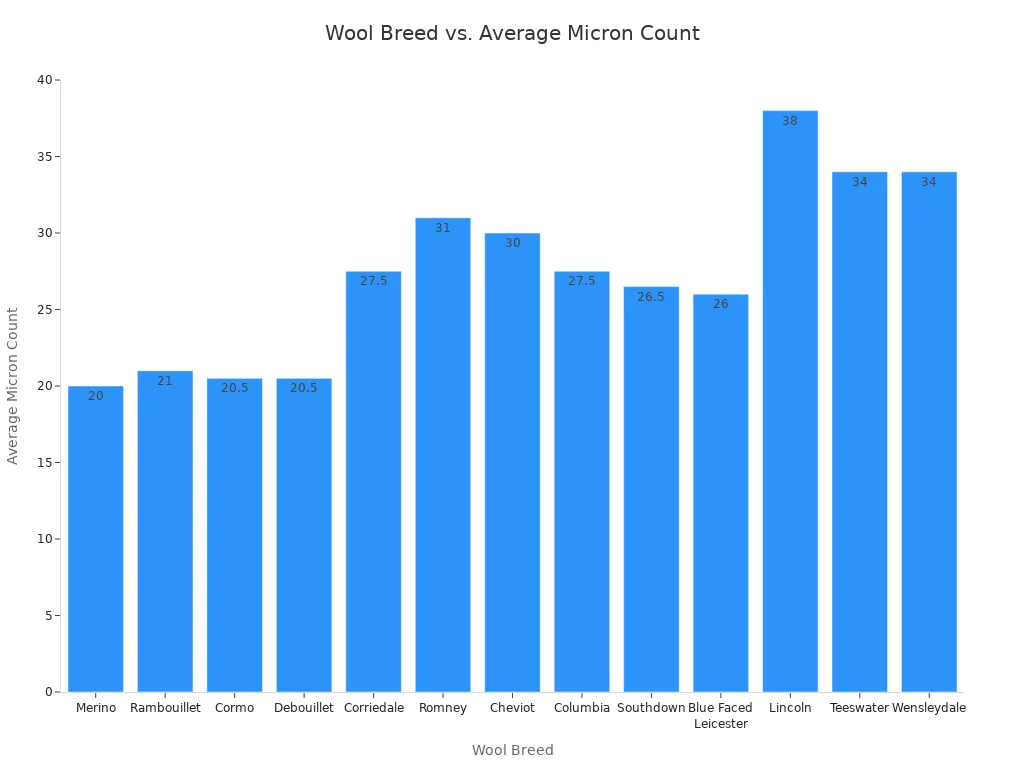
If you want your needle felted animals to look soft and lifelike, Merino is a great choice. For projects that need to hold their shape, Corriedale or Romney work better. Remember, lower micron numbers mean softer wool, while higher numbers give you more structure.
Tip: Try different types of needle felting wool to see which one you like best for your projects.
Core Wool vs. Top Coat
When you build needle felted animals, you usually start with core wool. This wool is coarser and less expensive. It felts quickly and makes a strong base for your project. You can use carded batts or slivers from breeds like Corriedale for the core. This helps you shape the body, head, and legs fast.
After you finish the base, you add a top coat. This is where you use softer, finer wool for needle felting, like Merino tops or roving. The top coat lets you add color, texture, and tiny details. If you want your animal to have fluffy fur or smooth skin, the top coat makes all the difference. You can even blend different shades to make your needle felted animals look more real.
Core wool gives your project strength and shape.
Top coat wool adds detail, color, and texture.
Mixing breeds and colors in the top coat helps you create lifelike effects.
If you’re just starting out, medium or coarse wool for needle felting is easier to use. It felts fast and holds its shape. As you get better, you can try fine Merino for detailed faces or paws. Many crafters use a blend of Merino and Corriedale to get both softness and strength in their needle felted animals.
Note: Almost any wool can work, but batts and roving are the easiest for beginners. Avoid combed top fibers for the core—they are harder to felt.
Choosing the Right Wool
Project Type
It is important to pick the right wool for your project. If you want to make 3D animals or sculptures, use coarser wool like Corriedale or Jacob for the inside. These wools felt fast and make your project strong. For the outside, use fine fibers like Merino or Blue Faced Leicester. These wools feel soft and let you add small details. They are great for pet portraits or soft clothes.
Here is a table that shows which wool is best for each project:
Project Type |
Wool Types Used |
Reason / Characteristics |
|---|---|---|
Base Shapes |
Corriedale, Mountain sheep, Jacob, Manx Loaghtan |
Coarser, sturdy, felts quickly; ideal for firm, large cores or base structures. |
Detailed Finishing & Fine Details |
Merino, Blue Faced Leicester, Shetland |
Soft, fine fibers; perfect for smooth finishes and intricate details. |
Textured or Soft Finishes |
Alpaca, Angora, Llama, Mohair, blends |
Adds softness, fluffiness, warmth, sheen, or texture; used for surface effects and color. |
You can use both needle felting and wet felting in one project. For example, needle felt details on a flat wet-felted background. This helps you add things that do not stick with wet felting. If you want fewer needle holes, try gentle needle felting first. Then use light wet felting after. This gives you more control over how your project looks.
Tip: Do not use superwash or blended wools for felting. Superwash wool has a coating that stops it from sticking. Your project might stretch or lose its shape. Blended wools can felt in a messy way and look uneven. Always use 100% wool for the best results and strong crafts.
Color and Sourcing
Picking the right color of wool makes your project stand out. You can use bright dyed wool for fun crafts. Or use natural colors for a classic look. Many people like natural shades for animal figures or clothes.
Think about where your wool comes from when you buy it. Buying from local farms or yarn shops helps the earth and your town. Look for labels like Responsible Wool Standard (RWS), ZQ Merino, or Woolmark. These show the wool is good for animals and the planet. Some brands sell recycled wool, which is better for the environment.
Here are some tips for picking wool that is good for the planet and lasts long:
Buy from brands that tell you where the wool comes from.
Look for labels like GOTS, Fair Trade, or OEKO-TEX.
Buy from local fiber sellers if you can.
Buy less but better wool to make less waste.
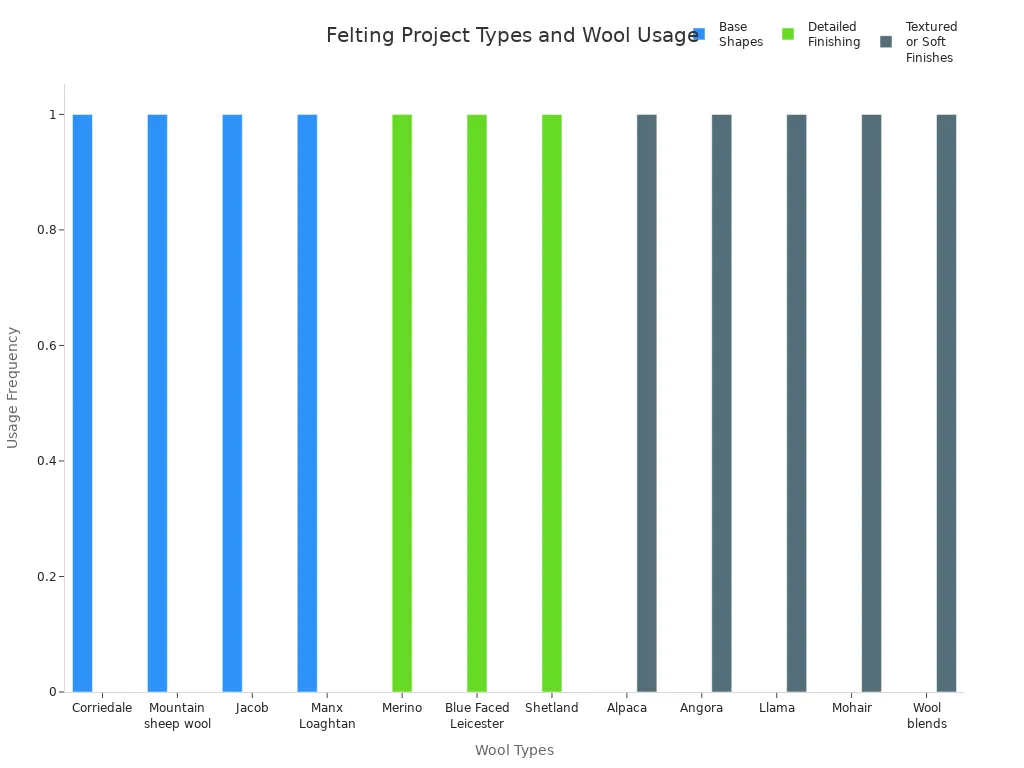
When you choose the right wool, your projects turn out better. You also help the planet. Your crafts will last longer, feel nice, and look great.
Felting Wool Quality
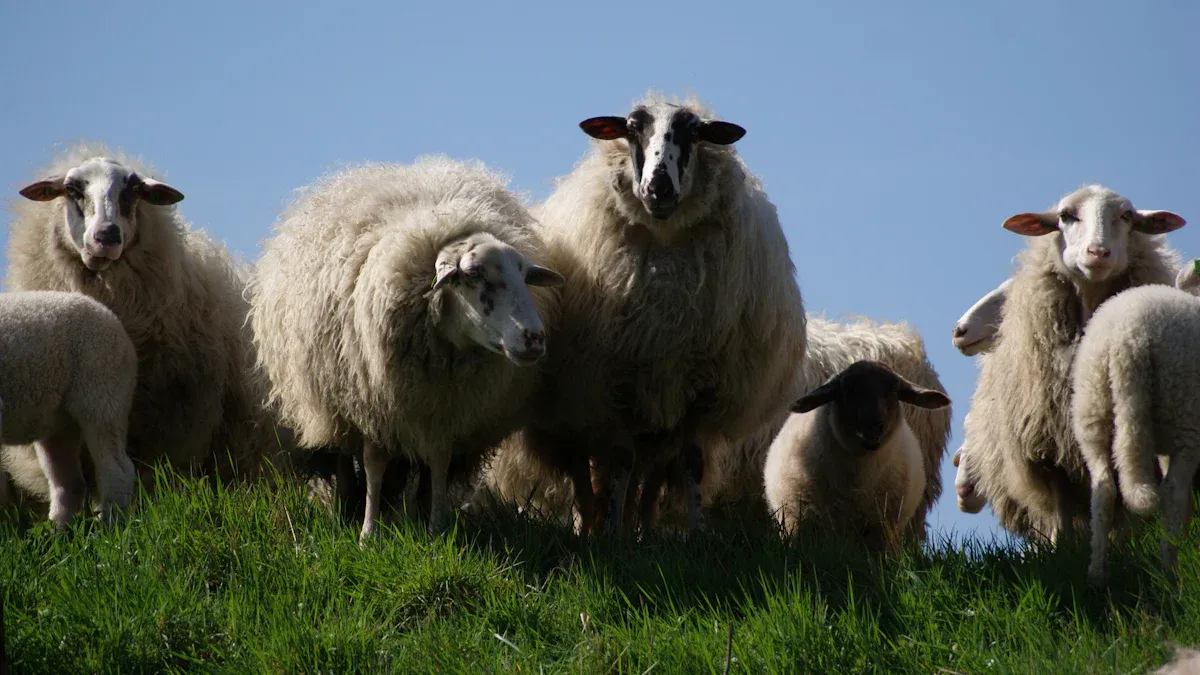
Evaluating Wool
When you want your felting projects to last, you need to check the quality of your wool. Start by looking at the micron count. This number tells you how fine the wool fibers are. Lower micron counts mean softer wool, which felts easily and gives a smooth finish. Merino wool, for example, is very fine and works well for detailed crafts and wearables.
Next, check the crimp. Crimp is the natural wave in the wool fiber. More crimp means the wool is springy and holds its shape. This helps your felted animals or wall hangings stay firm and bouncy. You also want to feel the wool. Soft, even wool feels nice in your hands and makes felting easier.
Watch out for guard hairs. These are thick, stiff fibers mixed in with the soft wool. Too many guard hairs make felting harder and can leave your finished piece looking rough. Always check for a clean, even texture. If you want the ultimate choice for durability, pick wool with a good balance of fineness and crimp, and avoid coarse, scratchy fibers.
Tip: Test a small piece before you start your big project. Make a tiny felt ball or patch. This helps you see how the wool felts and if it gives you the look and durability you want.
Where to Buy
Finding high-quality felting wool in 2025 is easier than ever. Local craft stores like Joann Fabric and Michaels carry a range of wool for felting. You can also shop online at places like Etsy, Amazon, and specialty shops such as The Wool Felt Company or Naylor Sew. Many artists prefer to buy directly from farms or small businesses. This way, you know exactly where your wool comes from and how it was raised.
When shopping, look for wool labeled as 100% natural. Avoid superwash or blended fibers, since they do not felt well and can ruin your project. Always read reviews and check for details about the breed and processing. If you want exceptionally durable items, choose thicker wool felt for structure and thinner felt for flexibility in wearables.
Here’s a quick checklist for buying wool:
Feel the wool if you can. Softness and crimp matter for felting and durability.
Ask about the sheep breed and how the wool was processed.
Avoid wool with lots of guard hairs or a rough feel.
For durability in wall hangings or crafts that get handled, pick wool with a strong, even texture.
High-quality wool makes your crafts last longer and look better. It keeps colors bright and shapes firm, even after years of display or use.
Choosing the right wool makes your felting projects shine. Here’s a quick checklist to help you pick the best wool every time:
Pick natural, non-synthetic wool for quality.
Check the sheep breed for the texture you want.
Look for staple length between 2.5 to 4 inches.
Make sure the wool is clean and even.
Try different breeds and brands to see what you like best.
Don’t be afraid to experiment! Every project helps you learn. Start your next felting craft—maybe a custom pet portrait—and watch your skills grow.
FAQ
What is the best wool for beginners in felting?
Corriedale wool works great for beginners. It felts quickly and holds its shape. You can shape it easily with your hands and felting needle. Try it for your first projects!
Can I use any wool for needle felting?
Not all wool works well. You need 100% natural wool. Superwash or blended wool does not felt. Always check the label before you buy.
How do I store my felting wool?
Keep your wool in a dry, cool place. Use a sealed bag or box. This keeps bugs and dust away. You want your wool clean and ready for your next project.
Why does my wool not felt together?
Your wool might be superwash or have too much oil. Try washing it gently. If it still does not felt, switch to a different wool breed.
Where can I find eco-friendly felting wool?
Look for local farms or shops that sell wool with labels like RWS or GOTS. Many online stores now offer eco-friendly options. Ask sellers about their sourcing if you are not sure.
